Lenses and Optics
Practical Use of Field Curvature Graphs – the 50mm Primes
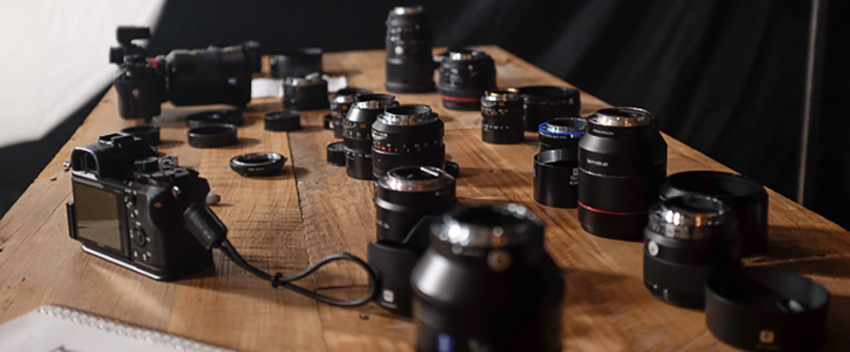
In my last two posts (1,2), I’ve been using field curvature graphs to look at how lenses behave as you stop them down. It’s been a fairly limited data set; basically 35mm prime lenses and some zooms at 35mm. I’m going to keep going with this topic and today look at a different focal length (50mm).
Over the next couple of posts I think we’ll take some of my ultra-geekiest data (field curvatures) and use that to show some practical points about how to choose a lens. And of course, my usual and constant nagging point about why ‘simplified’ lens assessments are pretty meaningless.
A Review of the Graphs
I’m going to use our more detailed 4-quadrant graphs for this post, so let me go over things about this graph once more.

Lensrentals.com, 2019
- Each of the 4 graphs shows the sharpness of the lens from one side to the other (left to right) with the center of the image in the center of the graph.
- From top to bottom, the graph is ‘front focused to back focused’. I put a black line across the graph to show best center focus. If the graph curves up, the best focus position is closer to the camera.
- The bottom two graphs show the sagittal (left) and tangential (right) planes. These are rarely the same.
- The upper right graph emphasizes where the planes are not the same. If there are red or blue areas, then one plane is front focused and the other back focused at that location; generally what you think of as astigmatism.
- The upper left graph is an average of sagittal and tangential planes. The idea of that graph was that it showed ‘average’ sharpness, but it’s not a very sensitive tool. I’d say if you see really bright red and blue areas in the ‘difference’ graph, the overall image is going to be a bit funky and astigmatic in that region even though the average may be reasonably sharp. Oh, and the bokeh there might be ugly too.
A Reality Check for Everyone
When you look at the MTF charts and other graphs we usually show, those are averages of 10 or more copies of the lens, each lens tested at multiple angles. Graphs of averages look nice and smooth out all the little foibles that individual copies have. And individual copies have foibles. Every. Single. One.
I learned long ago that nobody, and I mean nobody, wants to accept this, (unless they’re talking about some brand they don’t shoot; then they accept it just fine). Because I don’t like arguing on the interweb, I generally just minimize it. But we’re going to be looking at individual lenses now, and you’re going to see tilts and decentering.
So let’s get this out of the way. If I test at high enough resolution, every lens ever made has some tilt or decentering. We’re looking at 30 lp/mm which is medium resolution. Unless I note otherwise, every lens you see here meets MY standards for a good lens. Those are much higher than the manufacturer’s standards, but ‘MY standard’ doesn’t mean “perfect”. I’ve tested over 10,000 lenses in the lab. I haven’t seen a perfect one yet at lab standards.
PLEASE do not look foolish, like someone already has, and make generalizations from a few copies, like “It seems all of Brand X look tilted”. Yes, the two that I showed you of Brand X in a post looked tilted. I’ve looked at thousands, and I’ve mentioned when there are lenses that have a high frequency of optical issues.
Of the major brands (Canon, Nikon, Zeiss, Sigma, Sony, Tamron) all have some lenses where this is more common. None have a lens with no variation. You probably have some lenses of which you say “the field is completely flat” or “it’s perfectly centered”. The truth is the field is flat enough and the lens centered enough to make it your favorite lens. It’s not perfect.
I’m going to start the next section comparing two extremes from a copy variation standpoint to give you an example.
OK, Let’s Look at Some 50mm Lenses
I started with the 50mm focal length because most of them are a modified double-gauss optical design, so we would expect to see a lot of similarities.
First Let’s Look at Copy Variation – Zeiss Milvus 50mm f/1.4
In doing these tests, I send for an ‘off-the-shelf’ copy of the lenses I want, meaning a copy that has passed Lenrentals Inspection. The first copy they sent me was obviously decentered when I tested it on the bench. Enough so that I pulled its test and rental history. The lens had always tested as a pass on chart testing and on quick MTF testing after every rental, although it was at the lower end of a pass. It had rented a couple of dozen times without complaint. But you can clearly see that wide open it’s at it’s sharpest way over on the right side.
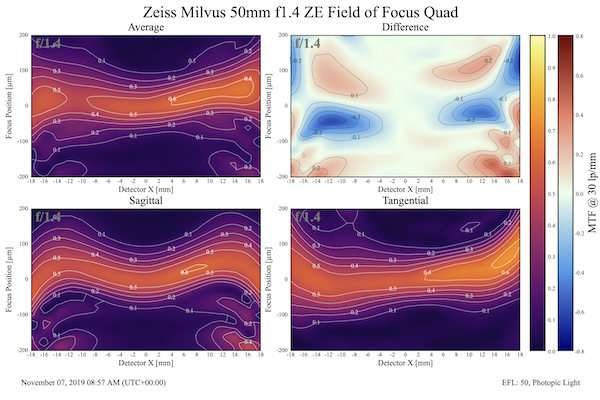
Lensrentals.com, 2019
So, I went through past testing and pulled an excellent copy for comparison. You can see it’s sharpest in the center and is sharper overall than the copy above.
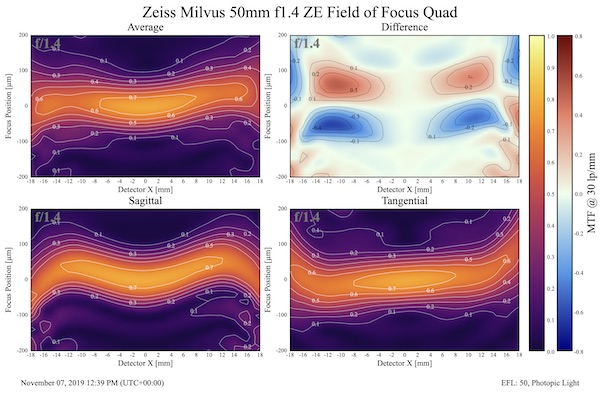
Lensrentals.com, 2019
My first point here is to show you how much ‘passing’ lenses vary in laboratory testing. The first lens was ‘OK’ on our testing, which is a higher standard than the manufacturer’s ‘in spec’ testing. It was used by a couple of dozen photographers without complaint. But it’s clearly not quite as good. Why is that?
Well, first of all, let’s remember the Milvus 50mm f/1.4 is considered ‘soft and dreamy’ wide open, getting sharp when you stop it down. So expectations among the photographers are probably lower. If someone took a landscape photo wide open and examined it at 50% magnification, they’d note that one side is softer than the other. They might even note that the side is sharper than the center. But that’s not something most people do with wide aperture 50mm lenses.
But they might do that comparison with this lens stopped down a bit, because it’s supposed to get very sharp at f/2.8. With that in mind, let me show you how the ‘bad copy’ behaves as we stop it down.
f/2
It’s still sharper on one side, but not as dramatically and the sharpest area is now in the center.
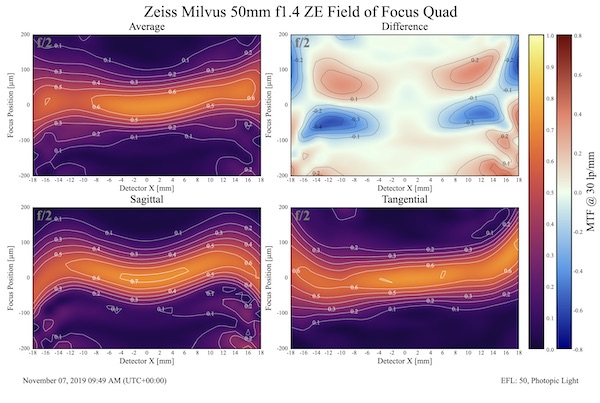
Lensrentals.com, 2019
f/2.8
It’s really quite even now. There’s a tiny bit of ‘lab test’ difference but absolutely nothing you could detect in a photograph.
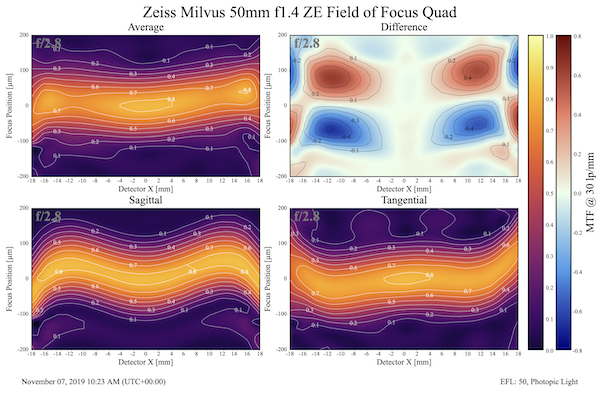
Lensrentals.com, 2019
f/5.6
This is the ‘bad’ copy, but there’s absolutely no difference, even at lab standards than it and the better copy.
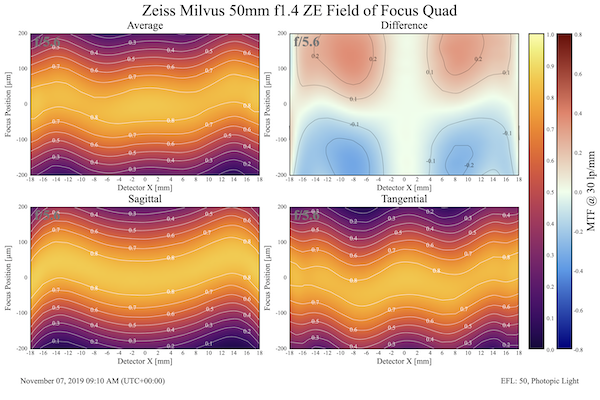
Lensrentals.com, 2019
So what’s the takeaway message here? Well, one is about evaluating lenses; I insist all lenses are tested wide open, stopping down a bit makes you miss some things. Some manufacturer’s standard testing (‘in spec’, if you will) is done stopped down to f/2.8 or f/4.
Another is just to emphasize that lab testing shows differences that might not affect you shooting the lens. On the other hand, it might affect someone else who shoots differently or has different priorities.
Finally, let’s talk about what field curvature shows us about the Milvus 50mm in general. Wide-open the curves are gentle, but sagittal and tangential are different and there is astigmatism. Stopped down to f/5.6 though, the depth of field covers the curves well; there is good side-to-side sharpness and the ‘difference’ graph shows just a soft pink and baby blue; there’s not significant astigmatism.
One More General Thing
All of the fields I’ve shown you have been at 30 lp/mm frequency, which is a good ‘overall’ picture. It’s important to remember, though, that depth of field, as well as sharpness, varies with frequency. (For those who aren’t up on this, lower frequency is more about larger objects and lower resolution sensors. Higher frequencies are about small detail and higher resolution sensors. If you want a contrasty object on a 24 megapixel sensor, 20 lp/mm is good. If you want to look at leaves or blades of grass on a 50 megapixel sensor, you probably are interested in 60 lp/mm.)
Here is the field curvature of that same 50mm f1.4 at f/5.6 but at 20 lp/mm.
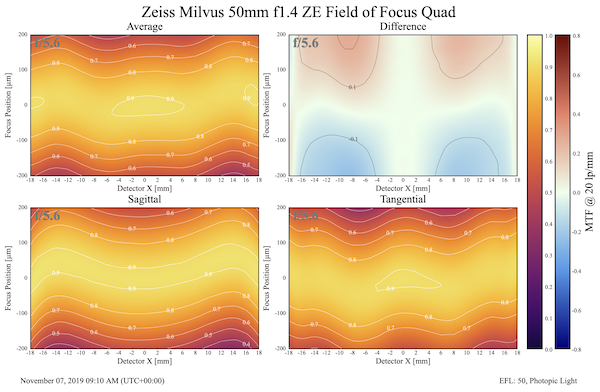
Lensrentals.com, 2019
And here it is at f5.6 but 60 lp/mm.
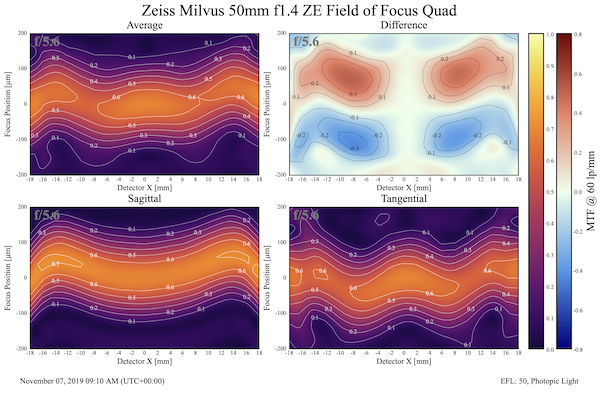
Lensrentals.com, 2019
I’m just trying to emphasize here that what is perfectly acceptable to one person may be unacceptable to someone else shooting different things or a different camera. At 60 lp/mm the fields no longer completely overlap at f/5.6 and there are some areas where sharpness is slightly reduced. It’s also why I tend to get amused at people who say things like ‘I calculated the depth of field should be 32 feet’. It is for something, but not for other things.
Let’s Compare to Some other 50mm Lenses
We’ve got a good baseline 50mm lens using the Zeiss Milvus 50mm f/1.4. Let’s see how it compares to some others. I’ll make some comments about my conclusions, comparing each lens to the Milvus 50mm f/1.4 so you don’t have to scroll back-and-forth too much. For each one I’m going to show you the fields wide open and at f/5.6.
Zeiss Milvus 50mm f/2 Makro
Remember, wide open is at f/2, so this might be most appropriately compared to the f/2 graph on the lens in the introduction. The curve is quite different, with a flat sagittal plane that curves only at the edges, and a shallow “W” shaped tangential plane. Overall, though, the fields are a bit less curved.
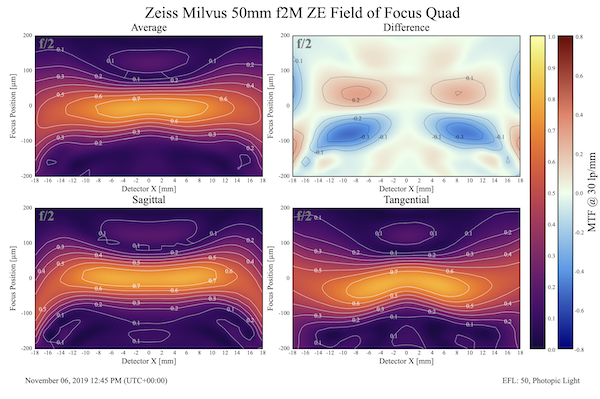
Lensrentals.com, 2019
Stopped down, the difference is more obvious. The curves match up well and there’s almost no astigmatism. However, the overall field is quite curved and this would be obvious in a photograph.
The 50mm f1.4 gives you a bit more astigmatism, but a flatter field. Depending on what you’re using the lens for, one is going to have advantages over the other. A skilled photographer who knows their lens is going to frame and set up images quite differently depending on which Milvus 50mm they are using.
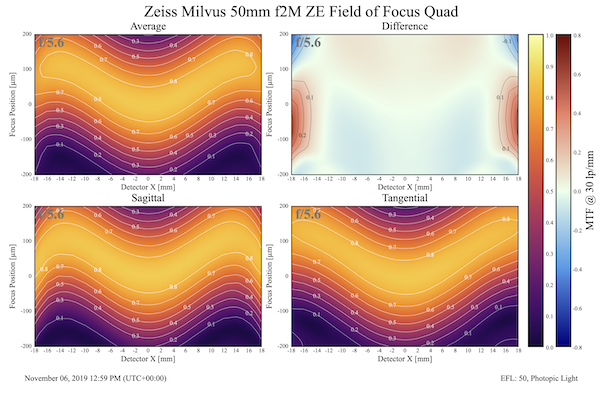
Lensrentals.com, 2019
Zeiss Otus 55mm f/1.4 Distagon T*
So why would anyone pay that much money for a lens, you might ask? Let’s see if the field curvature offers a bit of explanation. Wide-open you probably noticed the field is really flat; totally flat in the sagittal, a very gentle “W” curve in the tangential. One other thing I might mention: notice how sharply the field falls off; it goes from yellow to purple in a narrower range than the other lenses. So we have a very flat field, excellent sharpness even wide open, and a lens that goes from ‘in focus’ to ‘way out of focus’ in a short distance. Some people will pay a lot of money for that.
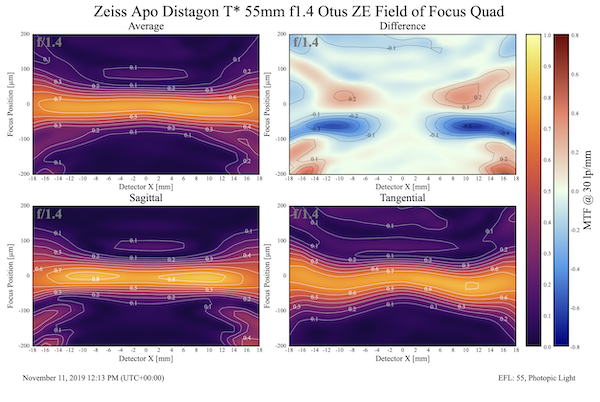
Lensrentals.com, 2019
What you don’t buy it for is performance at f/5.6. It’s still excellent, of course, but from these graphs, there’s nothing that says it’s awesomely better at f/5.6 than Milvus 50mm f1.4 was.
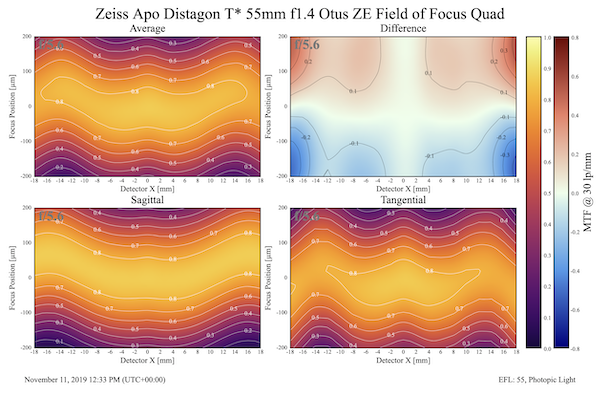
Lensrentals.com, 2019
Canon 50mm f1.2
This is something of a specialty lens with a unique look, but nobody buys it because of its absolute sharpness. You can see this in the wide-open field charts; it’s ‘adequately’ sharp in the center of the image but not away from the center, the field curvature makes even the ‘not very sharp’ off-center areas far off the plane of center focus.
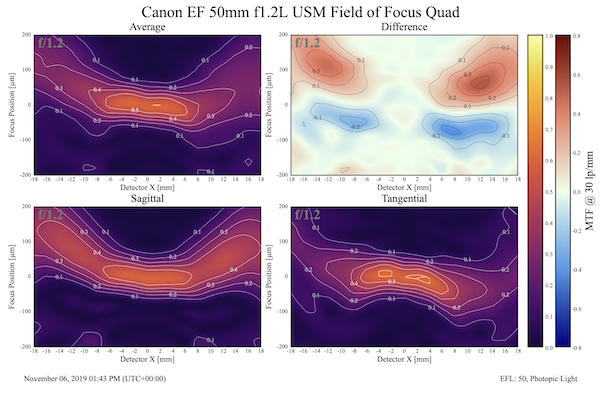
Lensrentals.com, 2019
Stopped down to f5.6 it has good center sharpness, but the mismatch of tangential and sagittal fields gives a lot of astigmatisms and the center 1/3 of the image is significantly sharper than the outer thirds. This is a very different tool than the other 50mm lenses we’ve looked at.
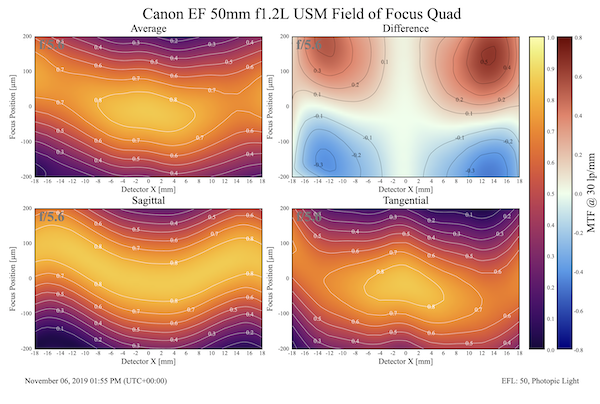
Lensrentals.com, 2019
I’m going to show you one more thing about the Canon 50mm f/1.2. This is a very old design, originally designed as a film lens. It exhibits a behavior that many old, wide-aperture primes have. Here is the Canon at f/5.6 as above, but this time showing the graph at 60 lp/mm. Notice the tangential field simply does not resolve 60 lp away from the center (you can scroll back and compare it to the slightly less old design of the Zeiss 50mm f1.4). The takeaway message is just demonstrating what most already know: the Canon 50mm f1.2 is a cool lens for certain purposes, but it does not make a good general-purpose 50mm lens.
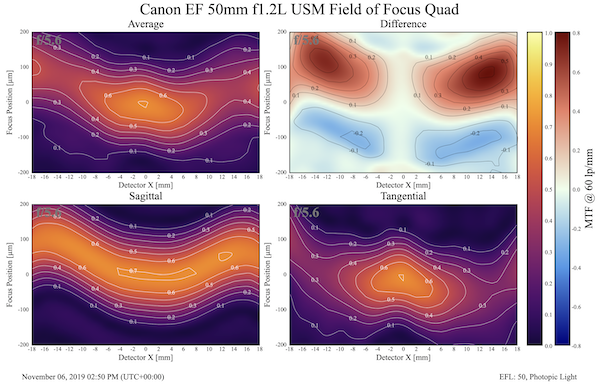
Lensrentals.com, 2019
Canon 50mm f1.4
Here’s another very old design, but one of the cheapest lenses you can buy. It’s not very sharp wide open but you can see the fields seem to curve in roughly the same direction.
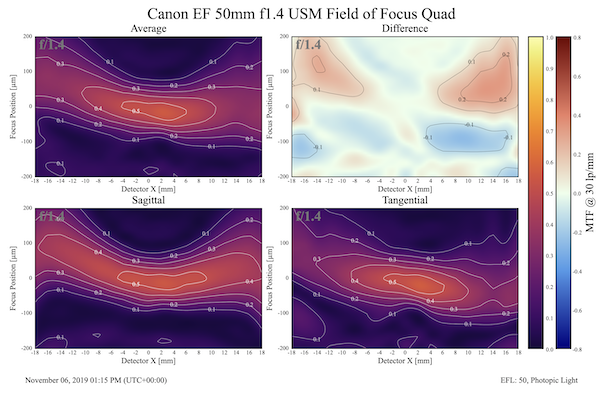
Lensrentals.com, 2019
Stopped down we can tell the field curvature isn’t a complete overlap, the sagittal is an “M” while the tangential is a very shallow “V”. But it gets quite sharp and the overlap is pretty good. The field does curve back at the edges, although not as dramatically as the Zeiss 50mm f/1.4. It’s a good example, though, of ‘if you’re going to shoot stopped down, an inexpensive lens may serve your purpose quite well’.
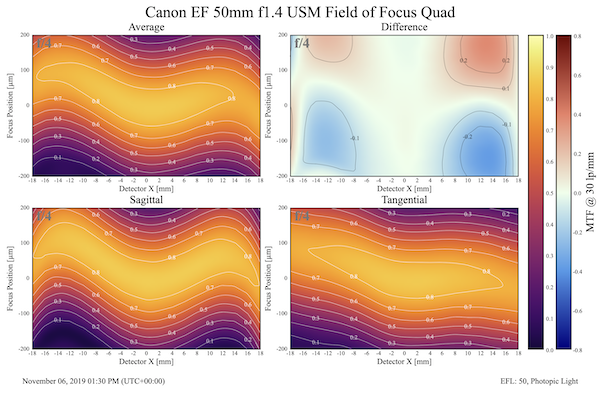
Lensrentals.com, 2019
Nikon 50mm f/1.4G
This is not the most popular tool in Nikon’s toolbox, but like the Canon 50mm f/1.4 it’s a really inexpensive prime lens. Wide-open it doesn’t have great resolution, although it’s a bit better than the Canon 50mm f1.4.
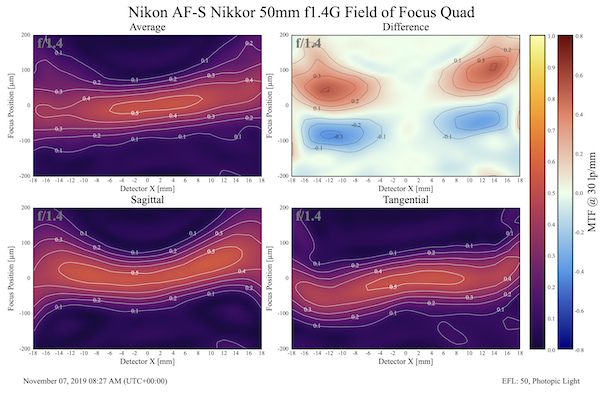
Lensrentals.com, 2019
Stopped down the tangential field never gets quite as sharp as the sagittal, the sagittal has a pretty significant “M” curve that keeps the fields from overlapping well, and overall there’s a slight field curvature back at the edges. The field curvatures demonstrate that it is what it is, a decent lens with no great characteristics. It’s still a bargain at the price, though.
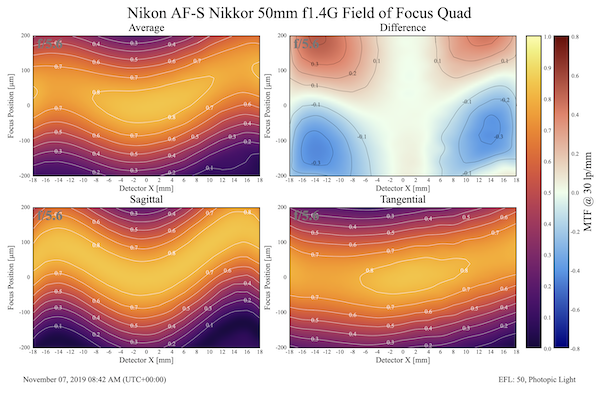
Lensrentals.com, 2019
Sigma 50mm f1.4 Art
This is an important comparison for a couple of reasons. It’s the newest design on this page by decades, except for the Zeiss Otus. And from purely an MTF standpoint it’s arguably the sharpest of the 50mm lenses other than the Otus. Wide open it’s obvious the resolution is higher in the center but the sagittal and tangential fields seem very similar.
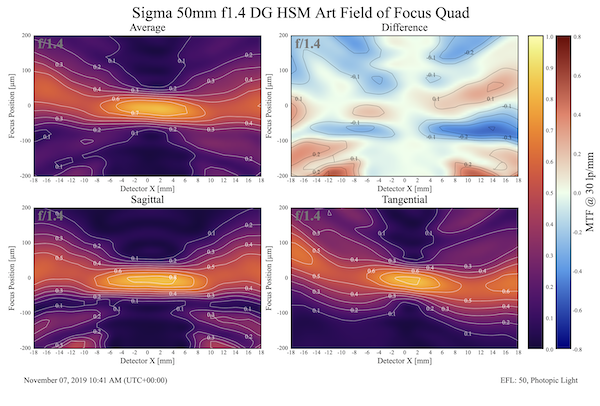
Lensrentals.com, 2019
At f/5.6 we see excellent sharpness. The fields overlap quite well except for the tilt of this copy, though. There clearly is going to be a bit of overall field curvature back toward the photographer, but it’s pretty mild.
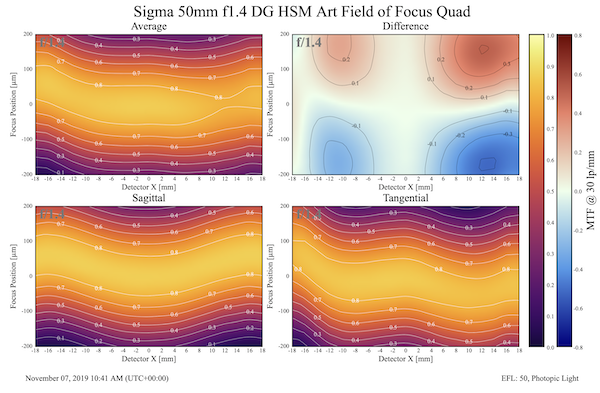
Lensrentals.com, 2019
So What Did We Learn Today?
Well, even in a set of prime lenses that have somewhat similar design and the same focal length, the field curvature gives some really useful information showing how these lenses behave differently.
If you’re going to shoot stopped down, 50mm seems a good focal length to go with an inexpensive lens, for one thing; there’s just no really obvious reason to spend for the Zeiss 55mm Otus to just shoot at f5.6.
If you tend to use this focal length for architecture, landscape, or other imaging that makes side-to-side sharpness important, then the flat fields of the Milvus 50mm f1.4 or Sigma 50mm f1.4 might be a better choice. If you want a center subject highlighted with the rest of the image soft, the Canon 50mm f/1.2 is for you!
For most of the 50mm lenses, though, there’s a noticeable field curvature with either the very edges, or ‘not-quite-to-the-edges’ areas coming into focus closer to the photographer than the center does. Focus-recomposing is going to be hit-or-miss unless you’ve developed a good, intuitive concept of the field curvature. You can do some interesting things with that field curvature, though, if you’re aware of it and frame your shot properly.
There’s more of a tendency of the 50mm lenses, compared to the 35mm lenses we looked at in the previous two posts (1,2), to be similar and to have a significant field curvature, though. That may also help you decide what focal length you want to use for a particular shot.
Roger Cicala and Aaron Closz
Lensrentals.com
November, 2019
Author: Roger Cicala
I’m Roger and I am the founder of Lensrentals.com. Hailed as one of the optic nerds here, I enjoy shooting collimated light through 30X microscope objectives in my spare time. When I do take real pictures I like using something different: a Medium format, or Pentax K1, or a Sony RX1R.
-
Dimy
-
Roger Cicala
-
Matthew Fitz
-
Brandon Dube
-
Federico Ferreres
-
Federico Ferreres
-
Carleton Foxx
-
Brandon Dube
-
hb
-
hb
